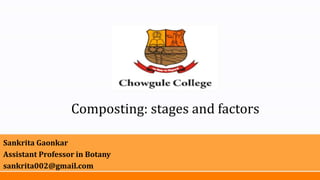
Composting: stages & factors affecting
- 1. Composting: stages and factors Sankrita Gaonkar Assistant Professor in Botany sankrita002@gmail.com
- 2. Contents • Composting • Stages of composting • Factors affecting composting • References
- 3. Composting • Definition - Decomposition of organic matter under aerobic conditions into humus-like substances and minerals by the action of microorganisms combined with chemical and physical reactions. • Organisms in composting require adequate amounts of macro- and micro- nutrients, oxygen, and water. • Compost stabilizes nutrient content of manures and other organic materials and releases nutrients slowly, minimizing nutrient loss and potential environmental contamination. • Mature batch of compost will take 6 to 8 months.
- 4. • Composting is predominantly an aerobic or oxygen-requiring process in which microorganisms consume oxygen while feeding on the organic matter. In doing so, they produce carbon dioxide, water, heat, other gaseous by-products, and compost. • As soon as the appropriate raw materials and water are mixed and brought together in a pile, composting process starts. In the presence of oxygen, microorganisms consume and start decomposing the organic matter. • The major group of microorganisms that participate in composting are bacteria, fungi and actinomycetes.
- 5. What Microbes Need? • Carbon (sugars) fuels their metabolism • Nitrogen (protein) makes enzymes used in decay process • Moisture transports and supports life functions • Oxygen • Hospitable environment
- 6. Microorganisms Involved in the Composting Process: Bacteria - Responsible for most of decomposition and heat generation in compost – Bacillus, Pseudomonas, and Arthrobacter. Fungi - Break down tough organic debris (Cellulose, hemicellulose, lignin) • Can decompose materials too dry, acidic, or low in nitrogen for bacterial activity – Aspergillus, Penicillium, Fusarium, and Trichoderma Actinomycetes - Degrade cellulose, lignin, chitin, proteins - Some species in thermophilic phase, others in curing phase
- 8. Three temperature stages of composting: 1. Mesophilic (20° – 45 °C) 2. Thermophilic (45° – 60 °C) 3. Mesophilic or curing (<45 °C) 4. Maturation phase (20 – 30 °C)
- 9. 1. Mesophilic • Bacteria break down cellulose into glucose (sugars, protein, starch) • Makes temperatures in pile rise • Produce endospores as pile heats up • Endospores – tough coating, resists heat, drying, UV radiation, chemicals, can survive next, hotter phase then return to active state when cool again 2. Thermophilic • Thermophilic bacteria, fungi take over • Heat-intolerant microbes go dormant • Pathogens destroyed • Complex carbohydrates fully broken down • Some proteins are decomposed • Hemicelluloses (more resistant) decay Endospore
- 10. 3. Mesophilic or curing • Mesophilic microbes return to active state • Proteins and carbs diminish • Metabolic activity decreases • Temperatures in pile drop • Lignin (most resistant plant component) decayed by actinomycetes, fungi • Physical decomposers support microbes • Matter gets exposed to bacteria as arthropods forage • Allows microbial populations to increase Earthworms, mites, spiders, ants, snails, sow bugs, slugs, nematodes, springtails, centipedes, etc
- 11. 4. Maturation Phase • During maturation phase the temperature of the compost pile drops to the ambient temperature • During this phase condensation of carbonaceous compounds and polymerization occurs, which further helps in formulation of fulvic and humic acids.
- 12. Factors affecting composting process 1. Aeration (Oxygen) 2. Carbon source 3. Moisture 4. Temperature 5. Carbon-nitrogen (C:N) ratio 6. pH 7. Particle size 8. Surface area
- 13. Aeration • Composting is an aerobic process and adequate ventilation should be maintained to allow respiration of microorganisms that release carbon dioxide (CO2) • aeration also helps in reducing compaction or water filling in the compost material. Moisture • water present in the raw material is used by the microorganisms for transportation of nutrient and energy through their cell membranes. • 55% - ideal moisture Carbon source • For energy • High carbon materials tend to be brown and dry
- 14. Temperature • Ambient temperature has a wide range of variation depending on the phase of the process. • Composting begins at ambient temperature that can rise up to 65 °C with no need of human intervention (external heating). While, during maturation phase the compost pile attains the ambient temperature. pH • The composting pH depends on the source materials and varies in each phase of the process (from 4.5 to 8.5 • The pH is a determinant factor for microorganisms’ survival and the various group of microorganisms have their optimal pH range for growth and multiplication. Most bacterial activity occurs at pH 6.0-7.5, while most fungal activity occurs at pH 5.5 to 8.0. The ideal range is from 5.8 to 7.2.
- 15. C:N ratio • The C:N ratio changes according to the parent material used for composting. • The C:N ratio varies throughout the composting process, with a continuous reduction from 35:1 to 15:1. Particle size • The ideal size of the parent materials for composting is 5 to 20 cm. • Affects the aeration and moisture retention of the compost pile Surface area • More the surface area, faster the decomposition
- 16. References • Kawai K and Gamaralalage PJ. 2020. CCET guideline series on intermediate municipal solid waste treatment technologies: Composting. United Nations Environment Programme. • Graves RE. 2000. Environmental Engineering National Engineering Handbook. Chapter 2-Composting. National Produdction Services, Fort Worth, Texas. • Meena AL , Karwal M, Dutta D and Mishra RP. 2021. Composting: Phases and Factors Responsible for Efficient and Improved Composting. Agriculture and Food: Newsletter, 3:85-90.